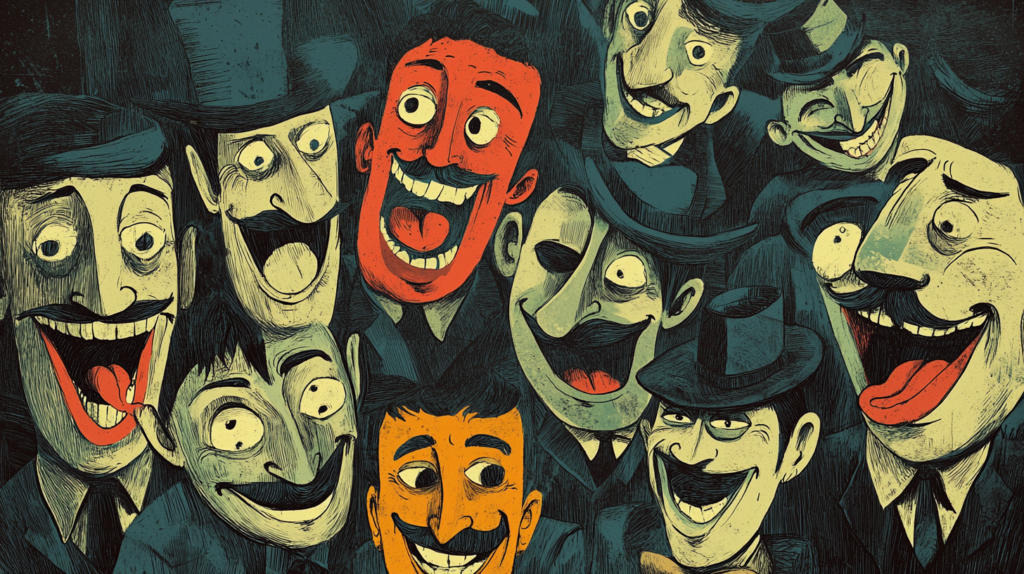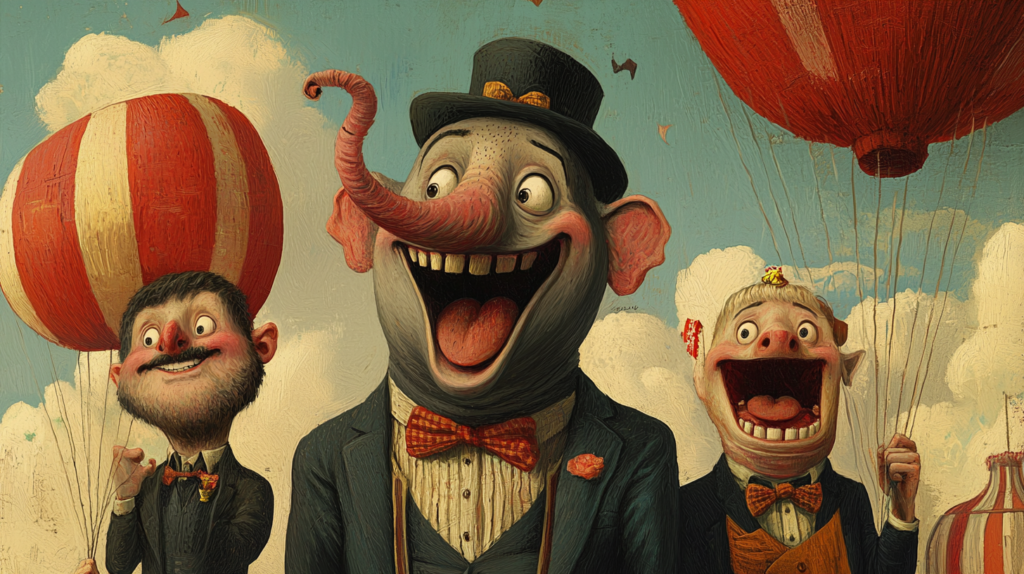Humor in illustration is a powerful tool used by artists to entertain, engage, and provoke thought. Whether through satire, exaggeration, or visual puns, humor allows illustrators to communicate complex ideas and emotions in a lighthearted way. Humor can be subtle or overt, intellectual or slapstick, but its purpose is universal: to evoke laughter, amusement, or reflection from the audience. As a cartoonist, humor is central to much of my work. It provides a way to explore serious issues while keeping the tone accessible and engaging. This article defines humor in illustration, explores the different forms it takes, and analyzes how it influences audiences.
What Is Humor in Illustration?
Humor in illustration refers to the use of visual elements and artistic techniques to create amusement or provoke laughter. It can manifest in various forms, including satire, irony, exaggeration, and absurdity. Illustrators use humor not only to entertain but also to offer commentary on social, political, or cultural topics. Through clever visual storytelling, humor often reveals truths that might otherwise be overlooked or downplayed.
Key Characteristics:
- Exaggeration: Humorous illustrations often exaggerate certain features or situations to emphasize their absurdity.
- Satire and Irony: Many humorous illustrations rely on irony or satire to critique societal norms, politics, or human behavior.
- Visual Puns and Wordplay: Combining visual elements with puns or playful language is a common method for creating humor in illustrations.
- Character Expressions: Over-the-top facial expressions and body language can evoke humor by highlighting characters’ reactions or emotions.
Examples:
- Political Cartoons: These often use satire to mock politicians or policies, offering humorous critiques of current events.
- Children’s Book Illustrations: Many children’s books use humor to engage young readers, with exaggerated characters, silly situations, and playful imagery.
- Comic Strips: Short, humorous comics like Peanuts or Garfield use humor to comment on everyday life, often through witty dialogue and visual gags.

The Role of Humor in Illustration
Humor plays a crucial role in illustration by making stories, ideas, and messages more engaging and accessible. Whether used for entertainment or commentary, humor in illustration captures the audience’s attention and provides a memorable experience.
1. Making Complex Ideas Accessible
Humor in illustration is often used to make complex or sensitive topics more accessible to a broad audience. By presenting serious issues through a humorous lens, illustrators can encourage reflection without overwhelming or alienating the viewer.
Example: A humorous political cartoon about climate change might depict a government official trying to “sweep” rising sea levels under a rug. The visual humor highlights the absurdity of ignoring the problem while drawing attention to the larger issue.
Personal Insight: In my work, I often use humor to simplify complex ideas and make them more digestible for readers. Whether addressing political corruption or social inequality, humor allows me to present these topics in a way that invites reflection rather than confrontation.
2. Engaging and Entertaining Audiences
Humor is a powerful tool for engaging and entertaining audiences. People are naturally drawn to content that makes them laugh, and humorous illustrations are more likely to capture attention and leave a lasting impression.
Example: Comic strips like Calvin and Hobbes use humor to entertain readers while exploring deeper themes like childhood, imagination, and friendship. The playful interactions between Calvin and his tiger, Hobbes, create an engaging experience that resonates with both children and adults.
Personal Insight: I’ve found that humor helps make my illustrations more relatable and engaging. Even when tackling serious subjects, a touch of humor can lighten the tone and make the work more approachable for a broader audience.
3. Providing Social and Political Commentary
Humor in illustration can also serve as a form of social and political commentary. Through satire, irony, and exaggeration, illustrators can highlight injustices, hypocrisy, or absurdities in society, encouraging viewers to question the status quo.
Example: Political cartoonist Herblock used humor to critique government corruption and social issues in the United States. His cartoons, filled with sharp wit and biting satire, pushed readers to reflect on the political climate and social norms of the time.
Personal Insight: When I use humor to address political or social issues, it’s often to provoke thought or challenge authority in a way that feels less confrontational. Humor allows me to critique systems of power while making the message accessible to a wide audience.
4. Humanizing Characters and Situations
Humor adds a layer of humanity to characters, making them more relatable and endearing. By depicting characters in humorous situations or with exaggerated emotions, illustrators create a sense of empathy and connection with the audience.
Example: In The Far Side comics, Gary Larson often depicts animals or everyday objects with human characteristics, creating humorous and sometimes absurd scenarios. These illustrations make even the most bizarre situations feel relatable and humorous.
Personal Insight: I often use humor to bring out the humanity in my characters. By giving them exaggerated reactions or placing them in humorous situations, I can make even the most fantastical characters feel grounded and relatable to readers.

Types of Humor in Illustration
There are various types of humor used in illustration, each with its own style and effect on the audience. From light-hearted visual gags to biting satire, illustrators use humor to convey different tones and messages.
1. Satirical Humor
Satirical humor uses irony, sarcasm, and exaggeration to criticize individuals, institutions, or societal norms. Satire is often used in political cartoons or social commentary illustrations to highlight hypocrisy, corruption, or injustice.
Characteristics:
- Irony: Saying one thing but meaning another, often to highlight contradictions.
- Critique: Using humor to expose flaws in society, politics, or human behavior.
- Exaggeration: Amplifying certain traits or situations to emphasize their absurdity.
Example: A political cartoon might depict a world leader as a puppet controlled by wealthy corporations, satirizing the influence of money in politics.
Personal Insight: Satire is a staple of my work, especially when addressing political or social issues. Through exaggerated caricatures and sharp humor, I’m able to critique those in power while making the message clear and engaging.
2. Visual Puns and Wordplay
Visual puns and wordplay involve using images and language in a clever or playful way to create humor. This type of humor relies on double meanings or plays on words to entertain the audience.
Characteristics:
- Double Meanings: Using visual elements that can be interpreted in more than one way.
- Wordplay: Combining visuals with clever language or puns for humorous effect.
- Surprise Factor: The humor often comes from the unexpected twist in meaning or interpretation.
Example: An illustration might show a literal “bookworm” reading a stack of books, playing on the common phrase used to describe someone who loves reading.
Personal Insight: I often enjoy using visual puns and wordplay in my work, especially when creating lighthearted or comedic pieces. They allow for clever, unexpected humor that engages the reader and makes them think twice about the meaning.
3. Exaggeration and Caricature
Exaggeration and caricature involve amplifying certain features or behaviors to create humor. In caricature, this often means exaggerating a person’s physical traits or mannerisms to emphasize their personality or role.
Characteristics:
- Physical Exaggeration: Amplifying specific features like large noses, big eyes, or exaggerated body proportions.
- Behavioral Exaggeration: Exaggerating actions or behaviors to highlight absurdity or humor.
- Character Traits: Using caricature to depict characters with exaggerated expressions or poses that reflect their personality.
Example: A caricature of a politician might emphasize their smug expression and inflated sense of self, exaggerating their ego for comedic effect.
Personal Insight: Caricature is a key element of my political cartoons. By exaggerating certain features or behaviors, I can highlight the traits or actions that define public figures, making the critique more humorous and impactful.
4. Slapstick and Physical Humor
Slapstick humor relies on physical comedy and exaggerated actions, often involving pratfalls, exaggerated gestures, or absurd situations. This type of humor is more visual and often relies less on dialogue or subtlety.
Characteristics:
- Physical Comedy: Humor derived from physical actions or situations, like characters tripping, falling, or bumping into things.
- Absurdity: Situations that are exaggerated to the point of being ridiculous, often evoking laughter through surprise or silliness.
- Exaggerated Reactions: Characters reacting in over-the-top ways to minor events, heightening the comedic effect.
Example: A comic strip might show a character attempting to fix a simple problem, only to end up in an increasingly absurd series of mishaps that leave them covered in paint or tangled in wires.
Personal Insight: While slapstick isn’t a major focus in my work, I enjoy using exaggerated physical reactions or absurd situations when I want to create light-hearted humor. It’s a great way to add a sense of playfulness to an illustration.
5. Absurd Humor
Absurd humor focuses on bizarre, illogical, or nonsensical situations that defy expectations. This type of humor often surprises the audience with its unexpected or strange twists.
Characteristics:
- Illogical Situations: Scenarios that don’t make logical sense but are funny because of their randomness or absurdity.
- Surprise: The humor comes from the unpredictability of the situation or outcome.
- Bizarre Imagery: Strange or surreal visual elements that provoke laughter through their unexpected nature.
Example: In a comic strip, a character might walk into what appears to be a normal room, only to discover a giraffe lounging on a couch reading the newspaper. The humor comes from the absurdity of the scenario.
Personal Insight: Absurd humor allows for creative freedom, and I often enjoy experimenting with bizarre or unexpected visuals to entertain readers. By pushing the boundaries of logic, absurd humor can surprise and delight audiences.

The Effect of Humor on Audiences
Humor in illustration has a profound impact on how audiences engage with the work. It not only entertains but also invites deeper reflection, connection, and emotional response. Below are some ways in which humor affects audiences.
1. Breaking Down Barriers
Humor helps to break down barriers between the artist and the audience, making difficult or sensitive topics more approachable. By using humor, illustrators can address serious issues without alienating or overwhelming the viewer.
Example: A humorous comic about mental health might depict the character’s struggles in a light-hearted way, using humor to make the topic more accessible while still conveying the underlying message.
Personal Insight: I often use humor to make serious topics more approachable, especially when addressing political or social issues. By introducing humor, I can create a space for reflection without making the audience feel defensive or uncomfortable.
2. Evoking Emotional Connection
Humorous illustrations often evoke a strong emotional connection with the audience. By depicting characters or situations that resonate with the viewer, illustrators can create a sense of empathy and relatability.
Example: A humorous illustration of a parent trying (and failing) to manage household chaos might resonate with readers who have experienced similar situations, creating a bond between the artist and the audience through shared experiences.
Personal Insight: I’ve found that humor helps humanize my characters, making them more relatable and endearing. When readers see themselves in a humorous situation, they’re more likely to connect emotionally with the story.
3. Encouraging Critical Thinking
Humor, especially in the form of satire or irony, encourages critical thinking by prompting the audience to reflect on the deeper meaning behind the joke. This type of humor often exposes contradictions, hypocrisy, or societal flaws, inviting viewers to question the status quo.
Example: A political cartoon using humor to critique environmental policy might depict world leaders holding an outdoor conference in a wasteland of pollution. The absurdity of the situation invites readers to think critically about the contrast between words and actions.
Personal Insight: Satirical humor is a powerful tool for encouraging reflection and critical thought. In my own work, I use humor to provoke readers to question authority or examine their own beliefs, making the message more impactful.
4. Creating Lasting Impact
Humor has the unique ability to create a lasting impact on the audience. A funny illustration is more likely to stick in the viewer’s mind, making them remember the message long after they’ve seen the image.
Example: A well-crafted political cartoon with a clever visual pun might be shared widely on social media, extending its reach and ensuring that the message resonates with a larger audience.
Personal Insight: Humor makes my work more memorable. When people laugh at or engage with a humorous illustration, they’re more likely to remember it and share it with others, giving the message greater longevity and reach.
Challenges of Using Humor in Illustration
While humor is a powerful tool, it also comes with challenges. Illustrators need to balance humor with sensitivity, ensuring that the joke doesn’t offend or alienate the audience.
1. Balancing Humor and Sensitivity
Humor, particularly when addressing sensitive topics like politics, race, or social issues, requires careful consideration. It’s important to ensure that the humor is thoughtful and doesn’t cross into offensive or harmful territory.
Personal Insight: I’m always mindful of the line between humor and insensitivity. While humor can be a great way to approach difficult topics, it’s important to avoid reinforcing stereotypes or causing harm, especially when addressing social or political issues.
2. Ensuring Clarity of Message
In humorous illustrations, it’s crucial to ensure that the message remains clear and doesn’t get lost in the joke. If the humor overshadows the core message, the illustration might not have the intended impact.
Personal Insight: I’ve learned to strike a balance between humor and clarity in my work. While it’s fun to play with exaggerated visuals and witty dialogue, I always keep the core message in focus to ensure that the humor enhances, rather than obscures, the point.
3. Cultural Sensitivity and Universality
Humor can be deeply rooted in cultural context, and what’s funny to one audience may not resonate—or may even offend—another. Illustrators must be aware of cultural differences when using humor, especially if their work is intended for a global audience.
Personal Insight: When creating humorous illustrations for an international audience, I try to ensure that the humor is universal enough to be understood across different cultures, while still maintaining the essence of the message.

Humor in Illustration
Humor in illustration is a versatile and powerful tool that allows artists to entertain, engage, and provoke thought. Whether through satire, visual puns, or exaggerated caricatures, humor adds depth to illustrations, making them more accessible and memorable. While humor comes with its own set of challenges, when used thoughtfully, it can help break down barriers, create emotional connections, and encourage critical thinking.
Final Thoughts:
As a cartoonist, humor is one of my favorite tools for connecting with audiences and sharing meaningful messages. It allows me to explore serious issues while keeping the tone light and engaging, and it often leads to a deeper emotional response from readers.
Call to Action:
For fellow illustrators, I encourage you to experiment with different types of humor in your work. Whether you’re aiming to entertain, critique, or inspire, humor can help make your message more impactful and memorable. For readers, take note of how humor influences your engagement with illustrations—what types of humor resonate with you, and how do they shape your understanding of the message? Share your thoughts in the comments below!





One Comment